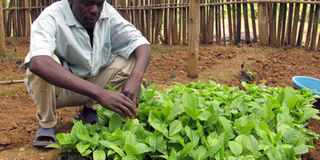How to get the best from a transplant

Before you transplant seedlings, there are certain precautions you need to take to get a good crop.
What you need to know:
Transplanting seedlings from the nursery to the garden is supposed to be an easy procedure. But if you are going to get a good crop, you need to transplant the seedlings properly.
Often, we are taken through the steps of planting and caring for seedlings in the nursery – the right amount of water, sun and covering. But rarely does someone come up to guide us on transplanting.
Below, a farmer, Mzee Solomon Omasete of Atiri Village in Tororo District, shares this with us:
Harden your seedlings
Start by putting them out in the sun for two hours every day. Then keep increasing the hours until you can keep them out a whole day. This enables them get used to the elements of weather before they are put in the soil.
Do it at the right time
If the seedlings are too small, they may die off quickly in the field. If they are too big, the roots may take long to get used to the soil in the field. Therefore, wait until the leaves are healthy and the seedlings are strong. If they start to grow tall and look weak, they are overdue.
Water before transplanting
Water them well a few hours before transplanting. Transplanting shocks them, so a well looked after plant will deal with the shock better.
Mind the weather
The best time for transplanting is when it is cool, or drizzling. Too much sun can disrupt your seedlings’ first steps. If it is a hot season, transplant early in the morning.
Dig your holes before hand
Dig your holes first. It is also advisable to put some fertiliser or compost in them before you can transplant. Your seedlings will need help while they are getting used to their new home. This will also keep the roots from too much sun and wind before you finish transplanting.
Be careful
Seedlings need careful handling. Take care especially not to crush the roots while you transplant. Using a knife to help lift it out is helpful, but it would be better if you use your hands because if you use a knife, you can cut the roots by mistake.
Mind the depth
You should know the type of seedlings you are dealing with. Not all seedlings are supposed to be planted at the same depth. For example, you should plant watermelon and cucumber seedlings a bit deep – the soil should come up to just below their first leaves.
But you should plant lettuce seedlings near the surface. Their roots should be just below the surface of the soil. Plant tomato, eggplant and pepper seedlings a bit deeper. Bury the stem and all the first leaves in the soil.
If you implement these measures, you will end up with a successful transplant.




